
Nevirapina
Descripción general
Descripción
Nevirapina es un inhibidor no nucleósido de la transcriptasa inversa que se utiliza principalmente en el tratamiento y la prevención de la infección por el virus de la inmunodeficiencia humana tipo 1 (VIH-1). A menudo se utiliza en combinación con otros medicamentos antirretrovirales para mejorar su eficacia. This compound funciona inhibiendo la enzima transcriptasa inversa, que es crucial para la replicación del VIH-1 .
Mecanismo De Acción
Nevirapina ejerce sus efectos uniéndose directamente a la enzima transcriptasa inversa del VIH-1. Esta unión provoca una interrupción en el sitio catalítico de la enzima, bloqueando así las actividades de la ADN polimerasa dependiente de ARN y del ADN dependiente de ADN. Esta inhibición impide la replicación del VIH-1, reduciendo la carga viral en el cuerpo del paciente .
Compuestos similares:
Efavirenz: Otro inhibidor no nucleósido de la transcriptasa inversa que se utiliza en el tratamiento del VIH-1.
Etravirina: Conocida por su eficacia contra las cepas de VIH-1 resistentes a otros inhibidores no nucleósidos de la transcriptasa inversa.
Rilpivirina: Un nuevo inhibidor no nucleósido de la transcriptasa inversa con un perfil de efectos secundarios favorable
Singularidad de this compound: this compound es única por su capacidad de prevenir la transmisión maternoinfantil del VIH durante el parto, una característica que no suele estar asociada a otros inhibidores no nucleósidos de la transcriptasa inversa. Además, su larga vida media permite una dosificación menos frecuente, lo que puede mejorar la adherencia del paciente al régimen de tratamiento .
Aplicaciones Científicas De Investigación
Nevirapine has a wide range of scientific research applications, including:
Análisis Bioquímico
Biochemical Properties
Nevirapine is extensively biotransformed via cytochrome P450 3A4 metabolism to several hydroxylated metabolites . This interaction with the cytochrome P450 3A4 enzyme plays a crucial role in the biochemical reactions involving Nevirapine.
Cellular Effects
Nevirapine has been shown to be effective in reducing HIV-1 levels when used in combination with other antiretroviral agents . It influences cell function by inhibiting the action of HIV-1 reverse transcriptase, an enzyme crucial for the replication of the virus .
Molecular Mechanism
The molecular mechanism of Nevirapine involves its binding to HIV-1 reverse transcriptase . This binding inhibits the action of the enzyme, thereby preventing the replication of the virus at the molecular level .
Temporal Effects in Laboratory Settings
It is known that Nevirapine is extensively metabolized in the liver, primarily via cytochrome P450 3A4 .
Metabolic Pathways
Nevirapine is involved in the metabolic pathway of cytochrome P450 3A4 . It is extensively metabolized in the liver to several hydroxylated metabolites .
Transport and Distribution
The transport and distribution of Nevirapine within cells and tissues are complex processes that involve its extensive metabolism in the liver
Subcellular Localization
Given its role as an inhibitor of HIV-1 reverse transcriptase, it is likely to be localized where this enzyme is present within the cell .
Métodos De Preparación
Rutas de síntesis y condiciones de reacción: Nevirapina se puede sintetizar mediante diversos métodos, incluida la condensación de 2-cloro-3-cianopiridina con ciclopropilamina, seguida de ciclación y metilación. Las condiciones de reacción normalmente implican el uso de disolventes como la dimetilformamida y catalizadores como el carbonato de potasio .
Métodos de producción industrial: La producción industrial de this compound a menudo implica una síntesis a gran escala utilizando rutas químicas similares, pero optimizadas para obtener mayores rendimientos y pureza. Las técnicas como la homogeneización a alta presión y la preparación de nanosuspensiones se emplean para mejorar la solubilidad y la biodisponibilidad del compuesto .
Análisis De Reacciones Químicas
Tipos de reacciones: Nevirapina experimenta varios tipos de reacciones químicas, entre ellas:
Oxidación: this compound se puede oxidar para formar varios metabolitos.
Reducción: Las reacciones de reducción son menos comunes, pero pueden ocurrir en condiciones específicas.
Sustitución: this compound puede sufrir reacciones de sustitución, particularmente en presencia de nucleófilos
Reactivos y condiciones comunes:
Oxidación: Los agentes oxidantes comunes incluyen el peróxido de hidrógeno y el permanganato de potasio.
Reducción: Se pueden utilizar agentes reductores como el borohidruro de sodio.
Sustitución: Los nucleófilos como las aminas y los tioles se utilizan a menudo en reacciones de sustitución
Productos principales: Los principales productos formados a partir de estas reacciones incluyen varios metabolitos y derivados de this compound, que pueden tener diferentes propiedades farmacológicas .
4. Aplicaciones de la investigación científica
This compound tiene una amplia gama de aplicaciones en la investigación científica, entre ellas:
Química: Se utiliza como compuesto modelo para estudiar los inhibidores no nucleósidos de la transcriptasa inversa.
Biología: Se emplea en la investigación sobre los mecanismos de replicación y resistencia del VIH-1.
Medicina: Parte integral de la terapia antirretroviral para la infección por el VIH-1. .
Comparación Con Compuestos Similares
Efavirenz: Another non-nucleoside reverse transcriptase inhibitor used in the treatment of HIV-1.
Etravirine: Known for its efficacy against HIV-1 strains resistant to other non-nucleoside reverse transcriptase inhibitors.
Rilpivirine: A newer non-nucleoside reverse transcriptase inhibitor with a favorable side effect profile
Uniqueness of Nevirapine: Nevirapine is unique due to its ability to prevent mother-to-child transmission of HIV during childbirth, a feature not commonly associated with other non-nucleoside reverse transcriptase inhibitors. Additionally, its long half-life allows for less frequent dosing, which can improve patient adherence to the treatment regimen .
Propiedades
IUPAC Name |
2-cyclopropyl-7-methyl-2,4,9,15-tetrazatricyclo[9.4.0.03,8]pentadeca-1(11),3,5,7,12,14-hexaen-10-one | |
|---|---|---|
| Source | PubChem | |
| URL | https://pubchem.ncbi.nlm.nih.gov | |
| Description | Data deposited in or computed by PubChem | |
InChI |
InChI=1S/C15H14N4O/c1-9-6-8-17-14-12(9)18-15(20)11-3-2-7-16-13(11)19(14)10-4-5-10/h2-3,6-8,10H,4-5H2,1H3,(H,18,20) | |
| Source | PubChem | |
| URL | https://pubchem.ncbi.nlm.nih.gov | |
| Description | Data deposited in or computed by PubChem | |
InChI Key |
NQDJXKOVJZTUJA-UHFFFAOYSA-N | |
| Source | PubChem | |
| URL | https://pubchem.ncbi.nlm.nih.gov | |
| Description | Data deposited in or computed by PubChem | |
Canonical SMILES |
CC1=C2C(=NC=C1)N(C3=C(C=CC=N3)C(=O)N2)C4CC4 | |
| Source | PubChem | |
| URL | https://pubchem.ncbi.nlm.nih.gov | |
| Description | Data deposited in or computed by PubChem | |
Molecular Formula |
C15H14N4O | |
| Source | PubChem | |
| URL | https://pubchem.ncbi.nlm.nih.gov | |
| Description | Data deposited in or computed by PubChem | |
DSSTOX Substance ID |
DTXSID7031797 | |
| Record name | Nevirapine | |
| Source | EPA DSSTox | |
| URL | https://comptox.epa.gov/dashboard/DTXSID7031797 | |
| Description | DSSTox provides a high quality public chemistry resource for supporting improved predictive toxicology. | |
Molecular Weight |
266.30 g/mol | |
| Source | PubChem | |
| URL | https://pubchem.ncbi.nlm.nih.gov | |
| Description | Data deposited in or computed by PubChem | |
Physical Description |
Solid | |
| Record name | Nevirapine | |
| Source | Human Metabolome Database (HMDB) | |
| URL | http://www.hmdb.ca/metabolites/HMDB0014383 | |
| Description | The Human Metabolome Database (HMDB) is a freely available electronic database containing detailed information about small molecule metabolites found in the human body. | |
| Explanation | HMDB is offered to the public as a freely available resource. Use and re-distribution of the data, in whole or in part, for commercial purposes requires explicit permission of the authors and explicit acknowledgment of the source material (HMDB) and the original publication (see the HMDB citing page). We ask that users who download significant portions of the database cite the HMDB paper in any resulting publications. | |
Solubility |
>39.9 [ug/mL] (The mean of the results at pH 7.4), In water, 100 mg/l @ neutral pH, 1.05e-01 g/L | |
| Record name | SID865943 | |
| Source | Burnham Center for Chemical Genomics | |
| URL | https://pubchem.ncbi.nlm.nih.gov/bioassay/1996#section=Data-Table | |
| Description | Aqueous solubility in buffer at pH 7.4 | |
| Record name | Nevirapine | |
| Source | DrugBank | |
| URL | https://www.drugbank.ca/drugs/DB00238 | |
| Description | The DrugBank database is a unique bioinformatics and cheminformatics resource that combines detailed drug (i.e. chemical, pharmacological and pharmaceutical) data with comprehensive drug target (i.e. sequence, structure, and pathway) information. | |
| Explanation | Creative Common's Attribution-NonCommercial 4.0 International License (http://creativecommons.org/licenses/by-nc/4.0/legalcode) | |
| Record name | NEVIRAPINE | |
| Source | Hazardous Substances Data Bank (HSDB) | |
| URL | https://pubchem.ncbi.nlm.nih.gov/source/hsdb/7164 | |
| Description | The Hazardous Substances Data Bank (HSDB) is a toxicology database that focuses on the toxicology of potentially hazardous chemicals. It provides information on human exposure, industrial hygiene, emergency handling procedures, environmental fate, regulatory requirements, nanomaterials, and related areas. The information in HSDB has been assessed by a Scientific Review Panel. | |
| Record name | Nevirapine | |
| Source | Human Metabolome Database (HMDB) | |
| URL | http://www.hmdb.ca/metabolites/HMDB0014383 | |
| Description | The Human Metabolome Database (HMDB) is a freely available electronic database containing detailed information about small molecule metabolites found in the human body. | |
| Explanation | HMDB is offered to the public as a freely available resource. Use and re-distribution of the data, in whole or in part, for commercial purposes requires explicit permission of the authors and explicit acknowledgment of the source material (HMDB) and the original publication (see the HMDB citing page). We ask that users who download significant portions of the database cite the HMDB paper in any resulting publications. | |
Vapor Pressure |
3.4X10-9 mm Hg @ 25 °C /Estimated/ | |
| Record name | NEVIRAPINE | |
| Source | Hazardous Substances Data Bank (HSDB) | |
| URL | https://pubchem.ncbi.nlm.nih.gov/source/hsdb/7164 | |
| Description | The Hazardous Substances Data Bank (HSDB) is a toxicology database that focuses on the toxicology of potentially hazardous chemicals. It provides information on human exposure, industrial hygiene, emergency handling procedures, environmental fate, regulatory requirements, nanomaterials, and related areas. The information in HSDB has been assessed by a Scientific Review Panel. | |
Mechanism of Action |
Nevirapine binds directly to reverse transcriptase (RT) and blocks the RNA-dependent and DNA-dependent DNA polymerase activities by causing a disruption of the enzyme's catalytic site. The activity of nevirapine does not compete with template or nucleoside triphosphates., The binding site for nevirapine on HIV-1 reverse transcriptase is near, but not at the proposed site of active polymerization, in a deep pocket lying between the beta sheets of the palm and at the base of the thumb subdomains of the enzyme's p66 subunit. In the absence of nevirapine, the binding of deoxynucleoside triphosphate to the reverse transcriptase-template complex results in a change in the conformation of reverse transcriptase. This conformational change is followed by a magnesium-dependent chemical reaction in which deoxynucleoside triphosphate is incorporated into the newly forming viral DNA; the conformational change appears to be the rate-limiting step of the reverse transcriptase catalysis of viral DNA formation. Nevirapine appears to have no appreciable effect on the rate of or equilibrium constant for the conformational change but may slow the chemical reaction, which then becomes the rate-limiting step in the catalytic sequence. When nevirapine binds to the reverse transcriptase-template complex, changes may occur in the position of aspartic acid carboxyl groups in reverse transcriptase so that magnesium ions are not in proper alignment for the chemical reaction to occur efficiently, and the reaction is slowed. Therefore, although the nevirapine-reverse transcriptase-template complex may continue to bind deoxynucleoside triphosphate and to catalyze its incorporation into the newly forming viral DNA, it appears to do so at a slower rate., The mechanism of action of nevirapine differs from that of nucleoside reverse transcriptase inhibitors (e.g., abacavir, didanosine, lamivudine, stavudine, zalcitabine, zidovudine). Nucleoside antiretroviral agents require intracellular conversion to triphosphate metabolites, which then compete with naturally occurring deoxynucleoside triphosphates for incorporation into viral DNA by reverse transcriptase and cause premature viral DNA chain termination by preventing further 5 to 3 phosphodiester linkages. Nevirapine, however, is noncompetitive with respect to primer-template or nucleoside triphosphate binding and is specific for HIV-1 reverse transcriptase. The drug binds directly to heterodimeric HIV-1 reverse transcriptase and appears to inhibit viral RNA- and DNA-dependent DNA polymerase activities by disrupting the catalytic site of the enzyme., Nevirapine diffuses into the cell and binds to reverse transcriptase adjacent to the catalytic site. This induces conformational changes that inactivate the enzyme. Resistance develops rapidly in cells exposed to nevirapine. High-level resistance is associated with mutations at reverse transcriptase codons 101, 103, 106,108, 135, 181, 188, and 190. A single mutation at either codon 103 or 181 decreases susceptibility more than 100 fold. Cross-resistance may extend to all FDA-approved nonnucleoside reverse transcriptase inhibitors, especially with the codon 103 mutation., Nevirapine is a highly specific inhibitor of HIV-1 reverse transcriptase, and results of in vitro studies indicate that nevirapine does not appear to inhibit cellular DNA polymerases, including human alpha-, beta-, Gamma-, or Delta-polymerases. | |
| Record name | Nevirapine | |
| Source | DrugBank | |
| URL | https://www.drugbank.ca/drugs/DB00238 | |
| Description | The DrugBank database is a unique bioinformatics and cheminformatics resource that combines detailed drug (i.e. chemical, pharmacological and pharmaceutical) data with comprehensive drug target (i.e. sequence, structure, and pathway) information. | |
| Explanation | Creative Common's Attribution-NonCommercial 4.0 International License (http://creativecommons.org/licenses/by-nc/4.0/legalcode) | |
| Record name | NEVIRAPINE | |
| Source | Hazardous Substances Data Bank (HSDB) | |
| URL | https://pubchem.ncbi.nlm.nih.gov/source/hsdb/7164 | |
| Description | The Hazardous Substances Data Bank (HSDB) is a toxicology database that focuses on the toxicology of potentially hazardous chemicals. It provides information on human exposure, industrial hygiene, emergency handling procedures, environmental fate, regulatory requirements, nanomaterials, and related areas. The information in HSDB has been assessed by a Scientific Review Panel. | |
Color/Form |
Crystals from pyridine and water | |
CAS No. |
129618-40-2 | |
| Record name | Nevirapine | |
| Source | CAS Common Chemistry | |
| URL | https://commonchemistry.cas.org/detail?cas_rn=129618-40-2 | |
| Description | CAS Common Chemistry is an open community resource for accessing chemical information. Nearly 500,000 chemical substances from CAS REGISTRY cover areas of community interest, including common and frequently regulated chemicals, and those relevant to high school and undergraduate chemistry classes. This chemical information, curated by our expert scientists, is provided in alignment with our mission as a division of the American Chemical Society. | |
| Explanation | The data from CAS Common Chemistry is provided under a CC-BY-NC 4.0 license, unless otherwise stated. | |
| Record name | Nevirapine [USAN:USP:INN:BAN] | |
| Source | ChemIDplus | |
| URL | https://pubchem.ncbi.nlm.nih.gov/substance/?source=chemidplus&sourceid=0129618402 | |
| Description | ChemIDplus is a free, web search system that provides access to the structure and nomenclature authority files used for the identification of chemical substances cited in National Library of Medicine (NLM) databases, including the TOXNET system. | |
| Record name | Nevirapine | |
| Source | DrugBank | |
| URL | https://www.drugbank.ca/drugs/DB00238 | |
| Description | The DrugBank database is a unique bioinformatics and cheminformatics resource that combines detailed drug (i.e. chemical, pharmacological and pharmaceutical) data with comprehensive drug target (i.e. sequence, structure, and pathway) information. | |
| Explanation | Creative Common's Attribution-NonCommercial 4.0 International License (http://creativecommons.org/licenses/by-nc/4.0/legalcode) | |
| Record name | nevirapine | |
| Source | DTP/NCI | |
| URL | https://dtp.cancer.gov/dtpstandard/servlet/dwindex?searchtype=NSC&outputformat=html&searchlist=759902 | |
| Description | The NCI Development Therapeutics Program (DTP) provides services and resources to the academic and private-sector research communities worldwide to facilitate the discovery and development of new cancer therapeutic agents. | |
| Explanation | Unless otherwise indicated, all text within NCI products is free of copyright and may be reused without our permission. Credit the National Cancer Institute as the source. | |
| Record name | nevirapine | |
| Source | DTP/NCI | |
| URL | https://dtp.cancer.gov/dtpstandard/servlet/dwindex?searchtype=NSC&outputformat=html&searchlist=641530 | |
| Description | The NCI Development Therapeutics Program (DTP) provides services and resources to the academic and private-sector research communities worldwide to facilitate the discovery and development of new cancer therapeutic agents. | |
| Explanation | Unless otherwise indicated, all text within NCI products is free of copyright and may be reused without our permission. Credit the National Cancer Institute as the source. | |
| Record name | Nevirapine | |
| Source | EPA DSSTox | |
| URL | https://comptox.epa.gov/dashboard/DTXSID7031797 | |
| Description | DSSTox provides a high quality public chemistry resource for supporting improved predictive toxicology. | |
| Record name | NEVIRAPINE | |
| Source | FDA Global Substance Registration System (GSRS) | |
| URL | https://gsrs.ncats.nih.gov/ginas/app/beta/substances/99DK7FVK1H | |
| Description | The FDA Global Substance Registration System (GSRS) enables the efficient and accurate exchange of information on what substances are in regulated products. Instead of relying on names, which vary across regulatory domains, countries, and regions, the GSRS knowledge base makes it possible for substances to be defined by standardized, scientific descriptions. | |
| Explanation | Unless otherwise noted, the contents of the FDA website (www.fda.gov), both text and graphics, are not copyrighted. They are in the public domain and may be republished, reprinted and otherwise used freely by anyone without the need to obtain permission from FDA. Credit to the U.S. Food and Drug Administration as the source is appreciated but not required. | |
| Record name | NEVIRAPINE | |
| Source | Hazardous Substances Data Bank (HSDB) | |
| URL | https://pubchem.ncbi.nlm.nih.gov/source/hsdb/7164 | |
| Description | The Hazardous Substances Data Bank (HSDB) is a toxicology database that focuses on the toxicology of potentially hazardous chemicals. It provides information on human exposure, industrial hygiene, emergency handling procedures, environmental fate, regulatory requirements, nanomaterials, and related areas. The information in HSDB has been assessed by a Scientific Review Panel. | |
| Record name | Nevirapine | |
| Source | Human Metabolome Database (HMDB) | |
| URL | http://www.hmdb.ca/metabolites/HMDB0014383 | |
| Description | The Human Metabolome Database (HMDB) is a freely available electronic database containing detailed information about small molecule metabolites found in the human body. | |
| Explanation | HMDB is offered to the public as a freely available resource. Use and re-distribution of the data, in whole or in part, for commercial purposes requires explicit permission of the authors and explicit acknowledgment of the source material (HMDB) and the original publication (see the HMDB citing page). We ask that users who download significant portions of the database cite the HMDB paper in any resulting publications. | |
Melting Point |
247-249 °C, 196.06 °C | |
| Record name | Nevirapine | |
| Source | DrugBank | |
| URL | https://www.drugbank.ca/drugs/DB00238 | |
| Description | The DrugBank database is a unique bioinformatics and cheminformatics resource that combines detailed drug (i.e. chemical, pharmacological and pharmaceutical) data with comprehensive drug target (i.e. sequence, structure, and pathway) information. | |
| Explanation | Creative Common's Attribution-NonCommercial 4.0 International License (http://creativecommons.org/licenses/by-nc/4.0/legalcode) | |
| Record name | NEVIRAPINE | |
| Source | Hazardous Substances Data Bank (HSDB) | |
| URL | https://pubchem.ncbi.nlm.nih.gov/source/hsdb/7164 | |
| Description | The Hazardous Substances Data Bank (HSDB) is a toxicology database that focuses on the toxicology of potentially hazardous chemicals. It provides information on human exposure, industrial hygiene, emergency handling procedures, environmental fate, regulatory requirements, nanomaterials, and related areas. The information in HSDB has been assessed by a Scientific Review Panel. | |
| Record name | Nevirapine | |
| Source | Human Metabolome Database (HMDB) | |
| URL | http://www.hmdb.ca/metabolites/HMDB0014383 | |
| Description | The Human Metabolome Database (HMDB) is a freely available electronic database containing detailed information about small molecule metabolites found in the human body. | |
| Explanation | HMDB is offered to the public as a freely available resource. Use and re-distribution of the data, in whole or in part, for commercial purposes requires explicit permission of the authors and explicit acknowledgment of the source material (HMDB) and the original publication (see the HMDB citing page). We ask that users who download significant portions of the database cite the HMDB paper in any resulting publications. | |
Synthesis routes and methods I
Procedure details





Synthesis routes and methods II
Procedure details






Synthesis routes and methods III
Procedure details






Synthesis routes and methods IV
Procedure details





Synthesis routes and methods V
Procedure details




Retrosynthesis Analysis
AI-Powered Synthesis Planning: Our tool employs the Template_relevance Pistachio, Template_relevance Bkms_metabolic, Template_relevance Pistachio_ringbreaker, Template_relevance Reaxys, Template_relevance Reaxys_biocatalysis model, leveraging a vast database of chemical reactions to predict feasible synthetic routes.
One-Step Synthesis Focus: Specifically designed for one-step synthesis, it provides concise and direct routes for your target compounds, streamlining the synthesis process.
Accurate Predictions: Utilizing the extensive PISTACHIO, BKMS_METABOLIC, PISTACHIO_RINGBREAKER, REAXYS, REAXYS_BIOCATALYSIS database, our tool offers high-accuracy predictions, reflecting the latest in chemical research and data.
Strategy Settings
| Precursor scoring | Relevance Heuristic |
|---|---|
| Min. plausibility | 0.01 |
| Model | Template_relevance |
| Template Set | Pistachio/Bkms_metabolic/Pistachio_ringbreaker/Reaxys/Reaxys_biocatalysis |
| Top-N result to add to graph | 6 |
Feasible Synthetic Routes
Descargo de responsabilidad e información sobre productos de investigación in vitro
Tenga en cuenta que todos los artículos e información de productos presentados en BenchChem están destinados únicamente con fines informativos. Los productos disponibles para la compra en BenchChem están diseñados específicamente para estudios in vitro, que se realizan fuera de organismos vivos. Los estudios in vitro, derivados del término latino "in vidrio", involucran experimentos realizados en entornos de laboratorio controlados utilizando células o tejidos. Es importante tener en cuenta que estos productos no se clasifican como medicamentos y no han recibido la aprobación de la FDA para la prevención, tratamiento o cura de ninguna condición médica, dolencia o enfermedad. Debemos enfatizar que cualquier forma de introducción corporal de estos productos en humanos o animales está estrictamente prohibida por ley. Es esencial adherirse a estas pautas para garantizar el cumplimiento de los estándares legales y éticos en la investigación y experimentación.
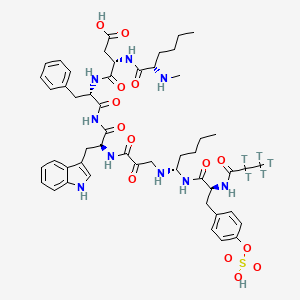
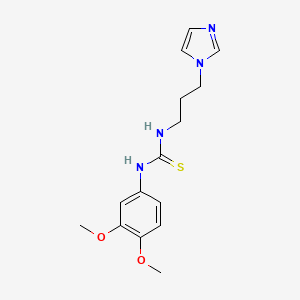
![N2-[[[5-[6-(Dimethylamino)-9H-purin-9-yl]pentyl]oxy]carbonyl]-D-arginine](/img/structure/B1678568.png)
![2-[4-(2-carbamimidoylsulfanylethyl)phenyl]ethyl carbamimidothioate;dihydrobromide](/img/structure/B1678570.png)
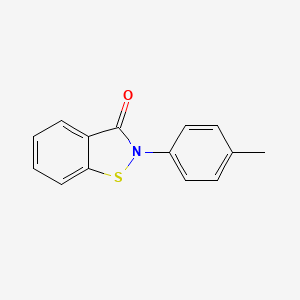
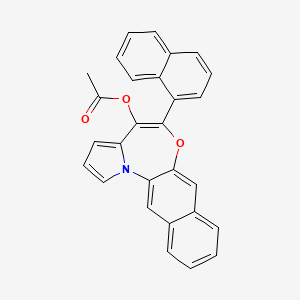
![3-((6-Chlorothiazolo[5,4-b]pyridin-2-yl)methoxy)-2,6-difluorobenzamide](/img/structure/B1678574.png)
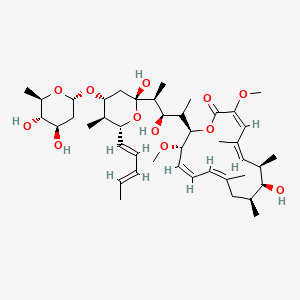
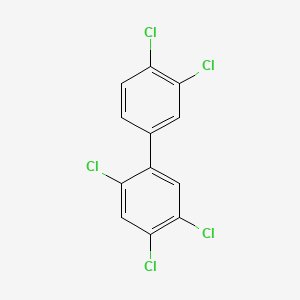
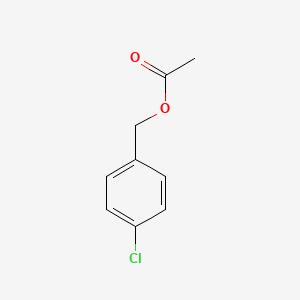


![[(1E,7E,9E,11E)-3,6,13-trihydroxy-1-(3-hydroxy-6-oxo-2,3-dihydropyran-2-yl)-3-methyltrideca-1,7,9,11-tetraen-4-yl] dihydrogen phosphate](/img/structure/B1678587.png)
![14-[2-(Diethylamino)ethyl]-10-[2-(2-hydroxyethylamino)ethylamino]-8-thia-14,15-diazatetracyclo[7.6.1.02,7.013,16]hexadeca-1(15),2(7),3,5,9,11,13(16)-heptaen-4-ol](/img/structure/B1678588.png)
